Learners will manage intrapartum fever and unplanned induction of labour.
You’re the on-call physician for obstetrics today in a rural 1A maternity site (no local cesarean section capabilities), and the nearest urban centre is 520 km away. It’s mid-December, and there is a massive snowstorm outside. You stoked the fire before bed, and you are now sound asleep. You get a call from the hospital at 0230. Nurse: “We just had a woman come in off the highway. She’s pregnant and at 39 weeks. She’s not in labour but is tachycardic and has a fever.”
35 y/o woman presents to the ED with her husband at 39 weeks gestation. Husband: “She’s been sweating profusely, shivering, and weak for the past few hours. I got her here as fast as I could.” She has a fever of 38.6 degrees Celsius, and her heart rate is 125 bpm. She is not having contractions.
She’s been receiving prenatal care from another community approximately 1230 km away. She’s had a normal prenatal course, has been well throughout the pregnancy, is nulliparous, and is carrying a singleton pregnancy. She’s Rh positive and GBS negative. She has no allergies, does not take any medications, and her family and medical history are insignificant. She does not smoke or drink alcohol.
The other physician, an RN, and an RPN are tied up in the ER with an acute trauma. The only people you have available for assistance is the RN and the woman’s husband.
The learner will (1) manage fever, (2) recognize indication for induction of labour, and (3) practice cervical ripening and induction of labour.
This simulation is part of ØRECLESS (Rural Emergencies and Complications in Labour Events Simulations Suite).
Overall Goal: Manage intrapartum fever and unplanned induction of labour to stimulate uterine contractions and progressive cervical dilatation to achieve a vaginal birth.
Specific Learning Objectives:
Time Recommended: 60 minutes total (10 min Setup | 20 min Scenario | 30 min Debrief)
Patient Recommendation: Standardized Patient + OB Mannequin + OB Trainer
Medical Equipment:
Medications:
Other:
|
This SIM requires one learner. Supporting roles can (1) be assigned to complete tasks by the learner, (2) provide assistance with maneuvers, and (3) provide statements throughout the SIM to allow for progression through the stages.
|
Moulage: Set up with the fetus in cephalic presentation, left occiput anterior position, and fetal station of -2.
Set-Up: The woman arrives at the ED sweating, shivering, and feeling very weak.
Note: While prepping for your simulation, don't forget to prep for the debrief. Become comfortable with your chosen framework, review your objectives. For additional debriefing resources, see our Resources page.
Original Author: Tiana Bressan
Originally published on: December 2, 2023
Most Recent Modification:
A good prebriefing is an essential component of running effective simulations, as it sets the stage for everything that comes after it1-3. An effective prebrief will create a safe container for learning, and in doing so, help participants feel more comfortable pushing their limits, sharing their thoughts and feelings, and buying into the experience. In turn, this will enhance engagement, participation, and learning. To that end, the prebriefing process needs to cover a lot of information1-5, which can make it daunting to novice or non-expert facilitators. To help, we have consulted the relevant literature and put together a prebrief guide to ensure that you have the tools you need to run an effective pre-briefing session.
Throughout the pre-brief, it is important that you convey your commitment to respecting learners and their perspective2-4, and establish and maintain the simulation as a safe space for learning1,4,5.
Prebrief Guide (Sample Phrases in Italics)
Welcome learners. Introduce yourself, your role, and your experience with simulation.
Go over the time requirements for the simulation, when breaks will occur, how learners should handle incoming calls or texts, etc.
Clarify the learning objectives for the simulation1-5. Give information on the purpose of the simulation without giving out specific actions or information that might compromise the learning experience for participants.
Explain how participants will be evaluated (formative/summative/not evaluated). Briefly discuss the debrief process that will take place at the end of the simulation.
Give details on what expectations are for the learners' behaviour during the simulation, setting basic ground rules2-5. Go over expectations for yourself as the facilitator. Reinforce the simulation as a learning environment, where mistakes aren't something to be punished but opportunities for further learning.
This could be a good place to pause and ask learners if they have any additional expectations, fears, comments, or questions about the topic for the day.
Ensure all participants agree to the confidentiality expectations of the simulation. Often, this will follow the mantra of "What happens in the simulation stays in the simulation," where learners and instructors agree not to share information on others' performance or scenario details outside of the simulation environment.
Explain that you've done what you can to make the simulation as real as possible, but acknowledge the limitations. Ask the learner to commit to doing what they can to act as if everything was real, explaining that the quality of their learning will depend on their willingness to participate as fully as possible. For the first simulation with a new group, it could be helpful to explain the importance of a mutual fiction contract.
Explain the different roles in the simulation and assign learners to them. If you have predetermined scripts for certain roles, hand them out here.
Explain the resources that will be available for the participants to use, how they should call for help in the simulation, what your role will be in providing information.
Orient participants to simulation space, equipment, manikin, etc. This can also be done by allowing participants to explore the simulation space and manikin for themselves.
Ask for questions!
References
1. Rudolph JW, Raemer DB, Simon R. Establishing a safe container for learning in simulation: the role of the presimulation briefing. Simul Healthc. 2014 Dec;9(6):339-49. doi: 10.1097/SIH.0000000000000047. PMID: 25188485.
2. Leigh G, Steuben F. Setting Learners up for Success: Presimulation and Prebriefing Strategies. Teaching and Learning in Nursing. 2018; 13(3):185-189. https://doi.org/10.1016/j.teln.2018.03.004
3. Lecomte F, Jaffrelot M. Chapter 33 - Prebriefing and Briefing. Clinical Simulation. 2019; 2nd ed.; 471-482. https://doi.org/10.1016/B978-0-12-815657-5.00034-6.
4. INACSL Standards Committee (2016, December). INACSL standards of best practice: SimulationSM Facilitation. Clinical Simulation in Nursing, 12(S), S16-S20. http://dx.doi.org/10.1016/j.ecns.2016.09.007.
5. Simon R, Raemer D, Rudolph J. Rater's handbook for the Debriefing Assessment for Simulation in Healthcare (DASH) Rater Version. 2009. http://www.harvardmedsim.org/debriefing-assesment-simulation-healthcare.php.
You’re the on-call physician for obstetrics today in a rural 1A maternity site (no local cesarean section capabilities), and the nearest urban centre is 520 km away. It’s mid-December, and there is a massive snowstorm outside. You stoked the fire before bed, and you are now sound asleep. You get a call from the hospital at 0230. Nurse: “We just had a woman come in off the highway. She’s pregnant and at 39 weeks. She’s not in labour but is tachycardic and has a fever.”
35 y/o woman presents to the ED with her husband at 39 weeks gestation. Husband: “She’s been sweating profusely, shivering, and weak for the past few hours. I got her here as fast as I could.” She has a fever of 38.6 degrees Celsius, and her heart rate is 125 bpm. She is not having contractions.
She’s been receiving prenatal care from another community approximately 1230 km away. She’s had a normal prenatal course, has been well throughout the pregnancy, is nulliparous, and is carrying a singleton pregnancy. She’s Rh positive and GBS negative. She has no allergies, does not take any medications, and her family and medical history are insignificant. She does not smoke or drink alcohol.
The other physician, an RN, and an RPN are tied up in the ER with an acute trauma. The only people you have available for assistance are the RN and the woman’s husband.
|
Patient Chart |
||||||||||
|
Name: Anna Zugasti |
Age: 35 |
Gender: F |
Weight: 89.3 kg |
Height: 148 cm |
GA: 39 Weeks |
|||||
|
Temp: 39.2 |
HR: 110 bpm |
BP: 114/74 |
RR: 24/min |
O2Sat: 99% |
GCS: 15 |
|||||
| Presenting complaint: Fever. | ||||||||||
Anna, age 35, has just come off the highway presenting with a fever at 30 weeks gestation. The only people you have available for assistance are the RN and the husband of the woman.
Modifiers (in red): Actions by the learner (which will have a consequence) OR actions to prompt learner. Extra information, audio clips, etc. are provided below.
| Patient Vitals | ||||
| BP: 114/74 | HR (Rhythm): 110 bpm (Sinus Tachycardia) | RR: 24/min. | ||
| O2SAT: 99% | Temperature: 39.2 degrees Celsius | GCS: 15 | ||
| Expected Learner Actions |
|---|
|
Introduction (name and role) and confirmation of patient name and pronouns |
| 10 min. OR Actions Complete ⇒ 2. Cervical Ripening and Induction of Labour |
Pronouns: She/her
History of Presenting Complaint:
Pregnancy Records: Labs and records are otherwise normal. Rh positive. GBS Status: Negative.
Gestation: 39 Weeks
No. previous deliveries: Nulliparous
Pregnancy Complications: None.
Medication(s): None.
Other: No Allergies. Insignificant family history and past medical history. Denies any alcohol or use of cigarettes.
Variability: Not available.
FHR: 170 bpm (Normal Range = 120-160 bpm)
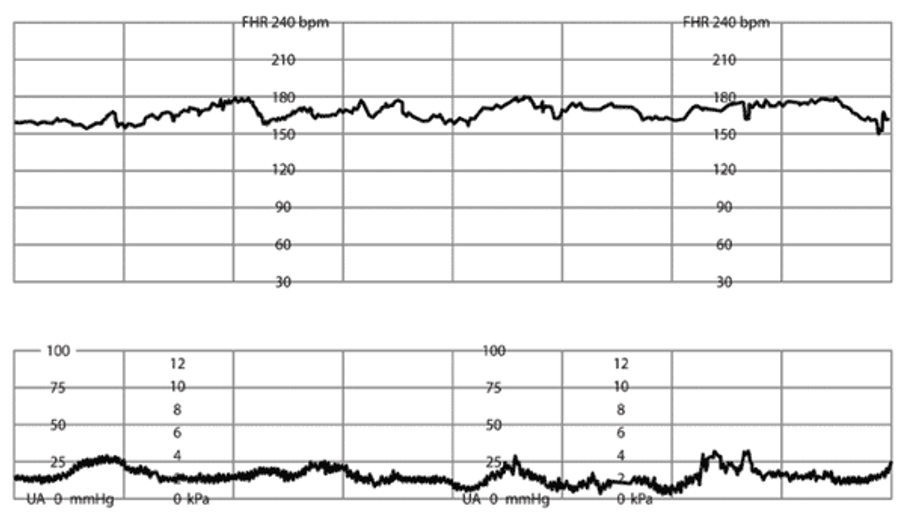
Online Figures A through L adapted from Bailey RE. Intrapartum fetal surveillance. In: Leeman L, ed. Advanced Life Support in Obstetrics Program: Provider Course Syllabus. Leawood, Kan.: American Academy of Family Physicians; 2009.
Bailey RE. Intrapartum fetal monitoring. Am Fam Physician. 2009 Dec 15;80(12):1388-96. PMID: 20000301.
General Abdominal Exam: No visible asymmetry, lesions, or scars. No appreciable masses, swelling, rigidity, or guarding. Uterine tenderness. Woman is 39 weeks pregnant.
Leopold Maneuvers:
Fundal Grip: Palpable soft, irregular mass.
Lateral Grip: Fetal back is on the right side and the limbs are felt on the left.
Pelvic Grip: Head is palpable.
Fetal Lie: Longitudinal.
Fetal Presentation: Cephalic.
Position: Right Occiput Anterior (LOA).
Uterine Activity Characteristics:
Frequency: N/A
Duration: N/A
Intensity: Mild to none.
Resting tone: Firm.
Dilation: 2cm
Fetal Station: -2
Effacement: 50%
Membrane: Ruptured, clear, and four odour
Bishop Score: Dilation (+1), Effacement (+1), Station (+1), Position (+2), Consistency (0) = 5 Points. Suggests unfavourable cervix and that induction may be necessary.
Chorioamnionitis has been diagnosed and management has begun for maternal fever and fetal tachycardia. Anna's vitals are otherwise normal and her temperature is now 38.9 degrees Celsius. The fetal heart rate tracing has been normal. She is not having contractions.
Modifiers (in red): Actions by the learner (which will have a consequence) OR actions to prompt learner. Extra information, audio clips, etc. are provided below.
| Expected Learner Actions |
|---|
|
Initiate contact with referral centre specialist
Laminaria or synthetic laminaria tents Pharmacologic Agents Facilitator selects FHR Tracing #1 or FHR Tracing #2 (in supporting documents) |
| 10 min. OR Actions Complete ⇒ 3. Case Complete. |
Tachysystole with Normal FHR

Society of Obstetricians and Gynecologists of Canada. ALARM Manual, 28th Ed. 2022.
Tachysystole with Abnormal FHR
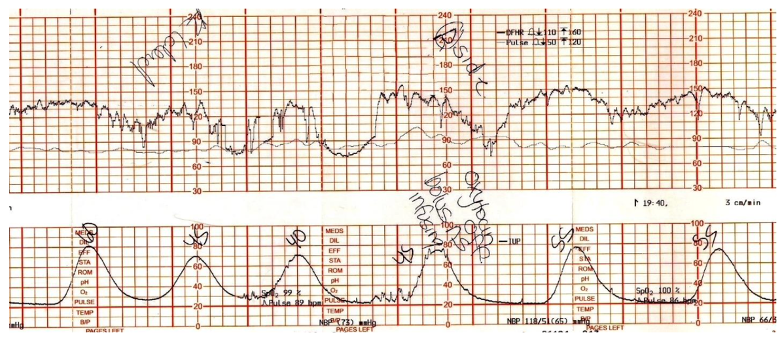
Society of Obstetricians and Gynecologists of Canada. ALARM Manual, 28th Ed. 2022.
Dilation: 6cm
Fetal Station: 0
Effacement: 80%
Membrane: Absent
Overt umbilical cord prolapse and the presence of pulsations within the cord vessels.
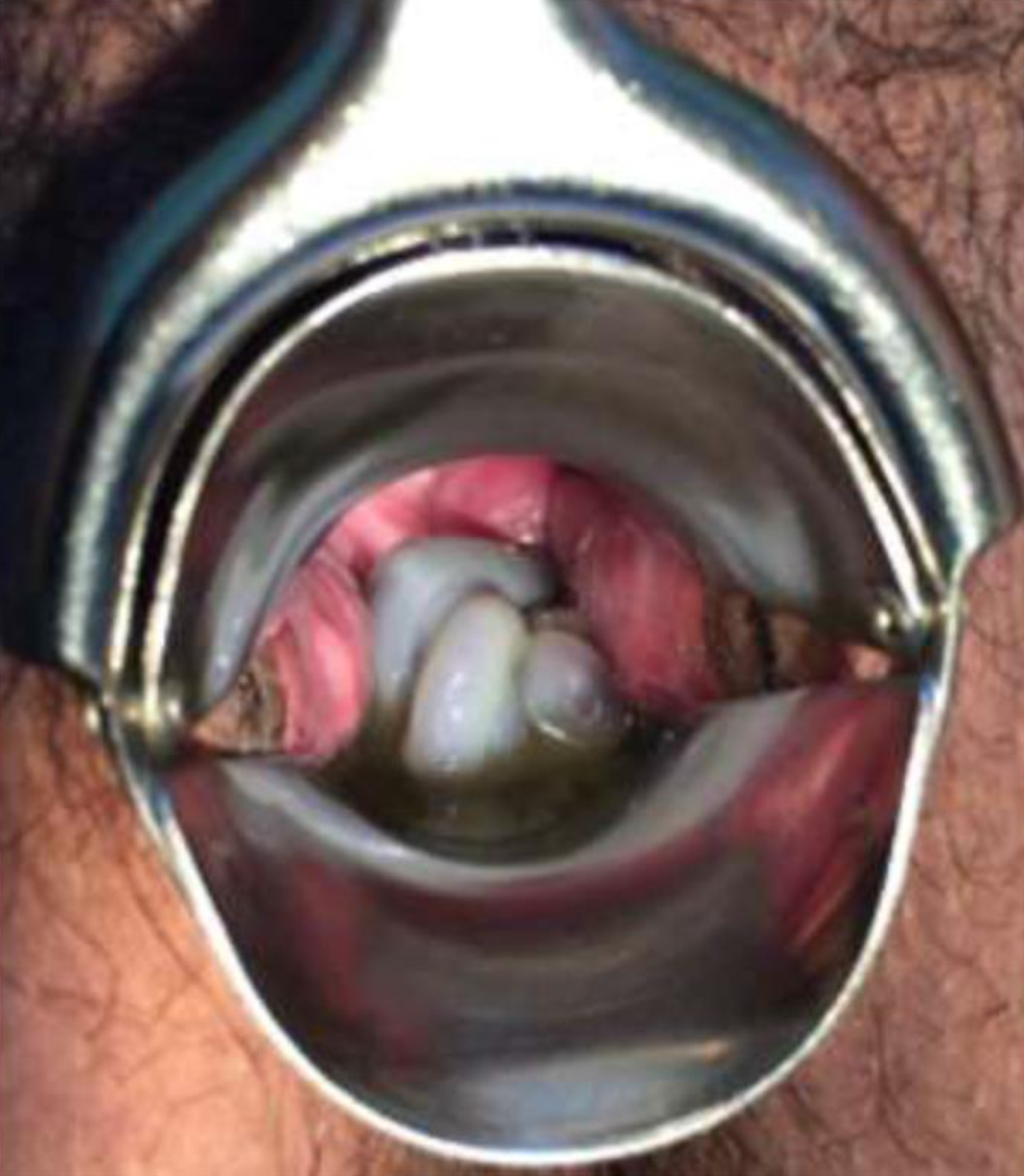
Park, M., Jung, Y.W., Park, J. et al. Successful delayed delivery of the second twin by evacuating the cord prolapsed first fetus and emergent cerclage: a report of 2 cases.BMC Pregnancy Childbirth 22, 113 (2022). https://doi.org/10.1186/s12884-022-04438-z
The perineum was properly protected and the baby was delivered. Apgar scores at one and five minute(s) are normal, the neonate is handed to the mother for skin-to-skin contact, and the case is complete.
|
Date and Time |
|
|---|---|
|
ID
|
CC
|
|
HPI: 4 Key Questions
|
Hx of Pregnancy
|
|
OBHx: Outcomes of previous pregnancies
|
|
|
PMHx
|
|
|
On Examination (O/E)
|
|
|
GxPx |
GTPAL |
|
G = Gravidity → total # of pregnancies |
G = Gravidity → total # of pregnancies
L = number of living children |
E.g., Patient has been pregnant 4 times. The first one ended in a miscarriage at 10 weeks, the second child was born healthy at 38 weeks, the third was carried to 23 weeks but was born stillborn and she is currently 35 weeks gestation with the fourth pregnancy.
This can be described as: G4P2 in GxPx format or G4T1P1A1L1 in the GTPAL format.

Retrieved July 2, 2023 from: https://www.parents.com/pregnancy/giving-birth/labor-and-delivery/cervix-dilation-chart-pictures-that-explain-the-stages-of-labor/

Retrieved July 27, 2023 from: https://www.instagram.com/p/CHJCbAhgdIu/?utm_source=ig_web_button_share_sheet
Retrieved July 27, 2023 from: https://www.youtube.com/watch?v=x17vY7_3M2M

Adapted September 12, 2023 from https://www.medicalnewstoday.com/articles/326380

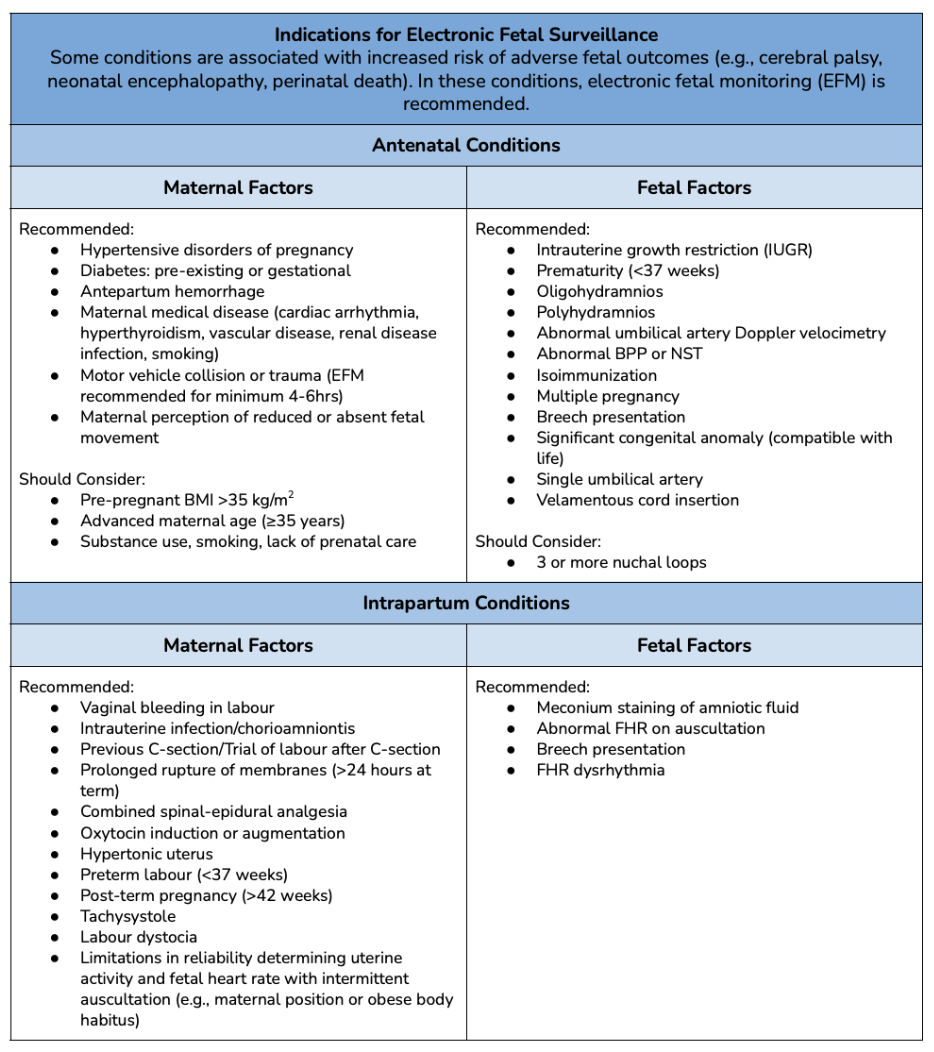
Reference(s):
Society of Obstetricians and Gynecologists of Canada. ALARM Manual, 28th Ed. 2022.
| FHR Pattern (VEAL) | Cause (CHOP) | Management (MINE) | |||
| V | Variable Deceleration | C | Cord Compression | M | Maternal Repositioning |
| E | Early Deceleration | H | Head Compression | I | Identify Labour Progress |
| A | Acceleration | O | Okay! | N | No Intervention |
| L | Late Deceleration | P | Placental Insufficiency | E | Evaluate (reposition, fluids, oxygen, emergency delivery). |
Retrieved July 17, 2023, from Melbourne University Obstetrics and Gynecology Society (Facebook)
Maternal Fever
Suspected Triple I
Confirmed triple I
Chen, K. T. Intrapartum fever. In: UpToDate, Barss V. A. (Ed), UpToDate, Waltham, MA, 2023.
|
Indications |
|
|
High Priority |
|
|
Other Indications |
|
|
Contraindications |
Risks |
|
|
Prevention Strategies (to reduce induction for post-term):
Inducing Labour: Pros and Cons of Membrane Sweep (7.5 min): https://youtu.be/I5AlkgUvPZY?t=57
Membrane Sweep (2.5 min): https://youtu.be/GOqIJdysn1g
Society of Obstetricians and Gynecologists of Canada. ALARM Manual, 28th Ed. 2022.

Important Notes Regarding Pharmacological use in Labour:
Options for Pharmacological Pain Management in Labour (see dosing information below):
Suggested Opioid use in labour:
|
Stage of Labour |
Nulliparous |
Parous |
|
Latent Stage: |
IM/SC Morphine |
IM/SC Morphine |
|
Early Active Stage: |
IM/SC or IV Morphine |
IV Morphine or Fentanyl |
|
Late Active Stage: |
IV Morphine or Fentanyl |
IV Fentanyl |
|
Second Stage: |
IV Fentanyl |
IV Fentanyl |
Reference(s):
Grant G. (2022). Pharmacologic management of pain during labor and delivery. In Crowley M (Ed.), UpToDate. Retrieved Jul 2, 2023, from https://www.uptodate.com/contents/pharmacologic-management-of-pain-during-labor-and-delivery
Society of Obstetricians and Gynecologists of Canada. ALARM Manual, 28th Ed. 2022.
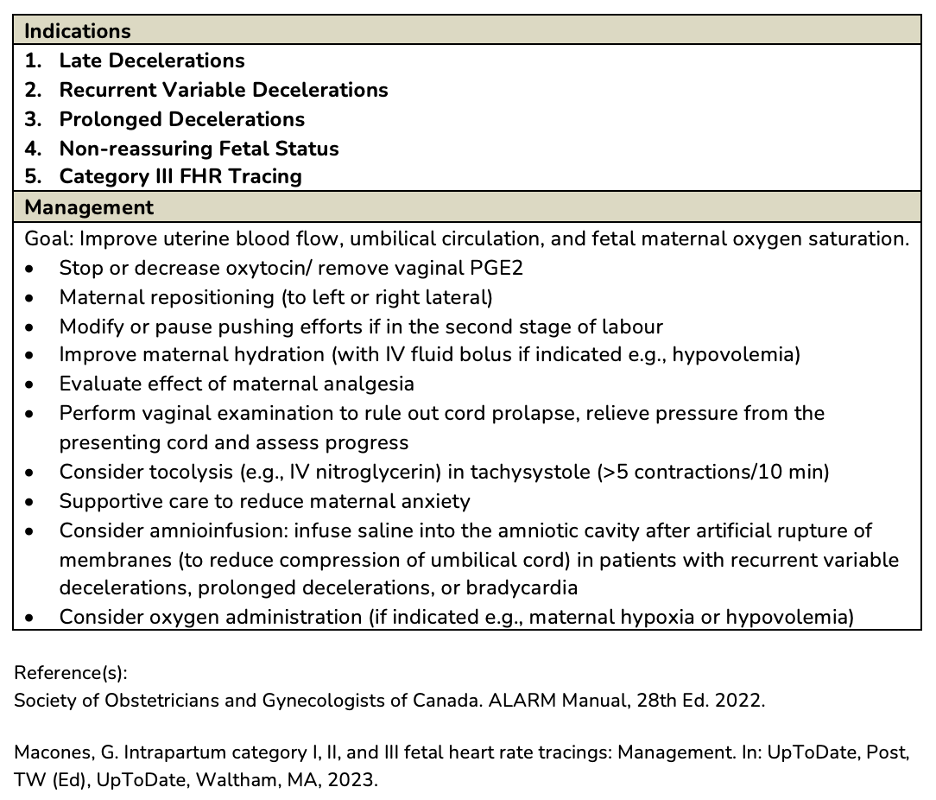

Retrieved July 13, 2023, from https://slideplayer.com/slide/7908096/
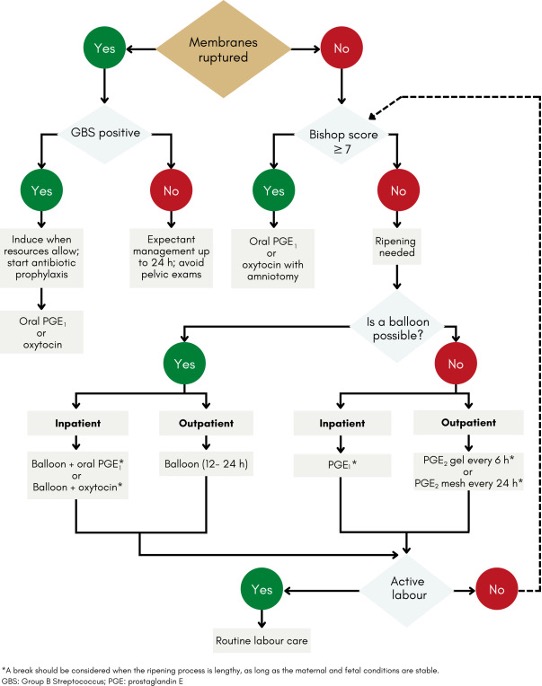
Retrieved July 13, 2023, from https://doi.org/10.1016/j.jogc.2022.11.009
|
Induction of Labour: Pharmacologic Options Agents Include:
General Prostaglandin Note(s):
Adverse reactions:
|
|
|
Prostaglandin E2 (Dinoprostone) – Intravaginal OR Intracervical Gel |
|
|
|
|
Intravaginal (Posterior Fornix) |
Intracervical |
|
|
|
Prostaglandin E1 (Misoprostol) |
|
Eligibility: Indication for IOL, >35 Weeks Gestation Caution: Multiparous (>6 prior vaginal deliveries), Fetal Growth restriction or oligohydramnios Exclusion Criteria: <35 Weeks Gestation, Previous CS (or significant uterine surgery), Abnormal Fetal Heart Tracing, Regular or Painful Contractions |
|
Society of Obstetricians and Gynecologists of Canada. ALARM Manual, 28th Ed. 2022.
Note(s): Tachysystole is the term used to describe excessive uterine activity:
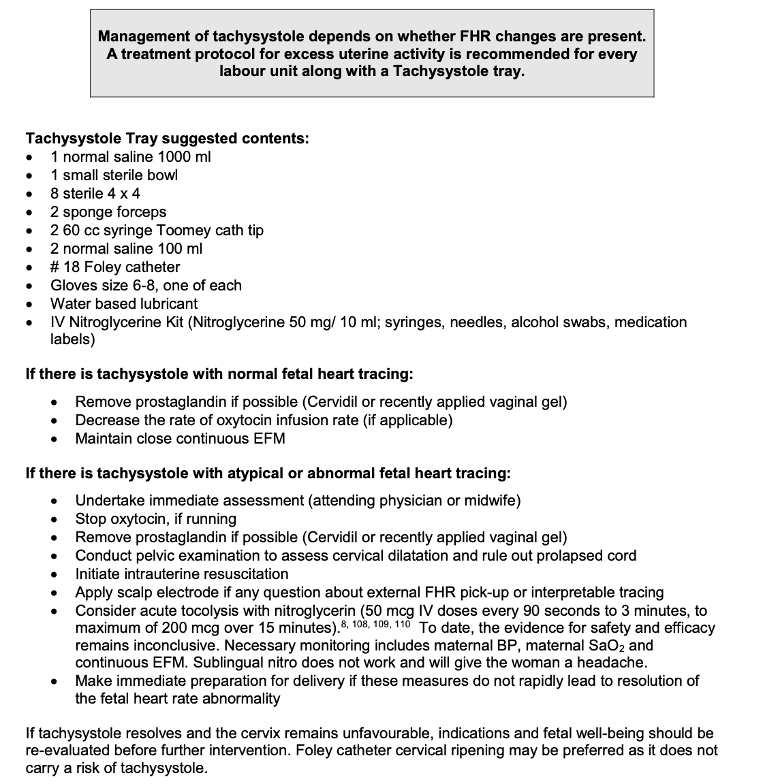
Society of Obstetricians and Gynecologists of Canada. ALARM Manual, 28th Ed. 2022.
Choosing a Debrief Framework:
A good debrief has been identified in the literature as the most important part of a successful simulation experience. If you're a novice or inexperienced facilitator, use this table to help you choose which debrief framework you want to use, just tap the button on their name and you will be directed to the appropriate aids or scripts. While we recommend the PEARLS framework, take a look to see if there may be another that is a better fit for your situation.
|
|
|||||
|
Time |
Facilitator Level |
Prep Time |
Scenario Type |
Flexibility |
|
|
Moderate |
Novice |
Moderate |
Any |
High |
|
|
Short-Moderate |
Novice |
Low |
Short w/ Clear Objectives |
Low |
|
|
Moderate |
Novice |
Moderate |
Any, esp. Team-focused |
Moderate |
|
|
Very Short |
No experience |
None |
Any |
Low |
|
|
Short |
Novice |
Low |
Low number of non-technical skills |
Low |
|
|
Very Short |
No experience |
None |
Any |
Moderate |
|
|
Moderate-Long |
Novice |
Moderate |
Any |
Moderate |
(To learn more about this debriefing framework, visit our page on Debriefing resources)
If you need help with debriefing Crisis Resource Management skills, check out this infographic from Isaak & Stiegler: View Infographic
|
Phase |
Objective |
Task |
Sample Phrases |
||
|
1. Setting the Scene |
Create a safe context for learning |
State the goal of debriefing; articulate the basic assumption |
“Let’s spend X minutes debriefing. Our goal is to improve how we work together and care for our patients.” “Everyone here is intelligent and wants to improve”
|
||
|
2. Reactions |
Explore feelings |
Solicit initial reactions and emotions
|
“Any initial reactions?” “How are you feeling?” |
||
|
3. Description |
Clarify Facts |
Develop a shared understanding of the case |
“Can you please share a short summary of the case?” “What was the working diagnosis? Does everyone agree?”
|
||
|
4. Analysis |
Explore a variety of performance domains:
|
See bottom of guide for details on the analysis phase |
For each item to be debriefed: 1. Preview Statement: (to introduce topic)
2. Pick Analysis method + Analyze: (see below for more info on each method)
3. Mini Summary: (to summarize discussion of topic)
Phase Wrap-up: "Any outstanding issues or concerns before we start to close?" |
||
|
5. Application or Summary |
Identify take-aways |
Can be learner- or instructor-centered |
Learner-centered: “What are some takeaways from this discussion for our clinical practice?”
Instructor-centered: “The key learning points for the case were [insert learning points]”
|
||
|
Analysis Phase Details |
|||||
|
Choose an analysis approach (Different approaches can be used for different topics within the same analysis stage): |
|||||
|
Approach |
Objective |
Sample Phrases |
|||
|
Learner Self-Assessment
|
Promote reflection by asking learners to assess their own performance |
“What aspects were managed well and why?”
“What aspects do you want to change and why?”
|
|||
|
Focused Facilitation
|
Probe deeper on key aspects of performance, uncover mental frames guiding performance |
Use Advocacy-Inquiry Method Advocacy: "I saw [observation], I think [your point-of-view]” "I noticed [observation] I liked that/I was concerned..." Inquiry: “How do you see it? What were your thoughts at the time?” |
|||
|
Provide Information
|
Teach to close clear knowledge gaps as they emerge and provide directive feedback as needed |
“I noticed[behaviour]. Next time you may want to consider [suggested behaviour], because [rationale]” |
|||
PDF from debrief2learn.org: Here
Visual Guide: debrief2learn.org
Alternative Script: Here
Originally Created by: Bajaj K, Meguerdichian M, Thoma B, Huang S, Eppich W, Cheng A. The PEARLS Healthcare Debriefing Tool. Acad Med. 2018, 93(2), 336.
(To learn more about this debriefing framework, visit our page on Debriefing resources)
If you need help with debriefing Crisis Resource Management skills, check out this infographic from Isaak & Stiegler: View Infographic
|
Phase |
Goal |
Actions |
Possible Scripts |
|
Gather (Listen)
25% |
|
|
How do you feel? |
|
How do you think it went? Can you tell me what happened? |
||
|
Can anyone add anything to that account? |
||
|
Analyze (Guide Reflection)
50% |
|
|
I noticed… |
|
I noticed…. What was the thought process behind…. When….happened, I saw….What do you think….. I saw…I think….How do you see it? |
||
|
Tell me more about… How did you feel about…. I understand, but tell me about X aspect of the scenario |
||
|
Summarize (Help gather Conclusions)
25%
|
|
|
What are two things that you thought were effective or went well? |
|
What do you think are some areas you/your team need to work on? |
||
|
In today’s session, we…. Going forward, we should…. |
References/Adapted From:
(To learn more about this debriefing framework, visit our page on Debriefing resources)
If you need help with debriefing Crisis Resource Management skills, check out this infographic from Isaak & Stiegler: View Infographic
Instructions:
|
Actions |
Gather |
Analyze |
Summarize |
|
Closed-loop communication
Clear Messages
Clear Roles
Knowing one’s limitations
Knowledge Sharing
Constructive Intervention
Reevaluation and Summarizing
Mutual Respect
|
Student Observations
Instructor Observations
|
Done Well
Needs Improvement
|
Student-led Summary
Instructor-led Summary
|
References/Adapted from:
(To learn more about this debriefing framework, visit our page on Debriefing resources)
If you need help with debriefing Crisis Resource Management skills, check out this infographic from Isaak & Stiegler: View Infographic
|
|
Set learning objectives |
|
After Case |
How did it go? Address Concerns Review learning points Plan ahead |
Framework from:
(To learn more about this debriefing framework, visit our page on Debriefing resources)
If you need help with debriefing Crisis Resource Management skills, check out this infographic from Isaak & Stiegler: View Infographic
|
Diamond Debrief: Sample Phrases |
|
Description |
|
“So what happened?...and then what happened next?”
Continue asking until confident that the details of the scenario have been raised by the learners
“Let’s not judge our performance now, let’s just focus on what happened” |
|
Transition |
|
“This scenario was designed to show…”
“Let’s address technical and clinical questions. What is the protocol for…?”
“How do we normally deal with this clinical situation?”
“Everyone ok with that?” |
|
Analysis |
|
“How did that make you feel?” To participants, then group “Why?” Then use silence
“How did you/they do that exactly?” “Why did you respond in that way? “ or “Why did you take that action?”
“It feels like…was an issue. Did it feel like that to you?” What I’m hearing from you is…is that correct?”
“This is part of…” (identify the non-technical skill/human factor) “We refer to that as a human factor or non-technical skill, which means…” |
|
Transition |
|
“So, what we’ve talked about in this scenario is…” “What have we agreed we could do?” |
|
Application |
|
“What other kinds of situations might you face that might be similar? How are they similar?”
“How might these skills we discussed play out in those situations?”
“What are you going to do differently in your practice going forward?” |
|
Underlying Principles |
|
Description |
|
Reinforce a safe learning environment. Situate the debrief in the shared and meaningful activity that occurred. Keep the focus dispassionate—discuss what happened but avoid focus on emotions. Listen for emotional responses but resist the temptation to discuss emotions. Make sure everyone shares the same understanding of what happened.
|
|
Transition |
|
Transition into analysis by clarifying any technical and clinical issues |
|
Analysis |
|
Spend most of your time in Analysis. Deconstruct behaviours into specific actions, and explore what happened in detail. Ask about affective responses and validate them. Analyze and interpret the activity by applying appropriate frameworks or lenses (such as non-technical skills, or the clinical context surrounding the scenario). Keep discussion positive, and avoid the temptation to focus on “strengths and weaknesses”. Reflect responses back, allowing participants to amend or augment. |
|
Transition |
|
Transition into Application by reinforcing learning. |
|
Application |
|
Focus on moving from the specifics of the scenario to the more general world of practice. Break behaviours down into specific actions. Explore the other kinds of situations that these might apply to. Ask what participants will do differently in their practice. |
Adapted From: Jaye P, Thomas L, Reedy G (2015). 'The Diamond': a structure for simulation debrief. The Clinical Teacher 12(1). 171-175. onlinelibrary.wiley.com/doi/full/10.1111/tct.12300
If you need help with debriefing Crisis Resource Management skills, check out this infographic from Isaak & Stiegler: View Infographic
Pluses:
Deltas:
|
Plus (+) |
Delta (∆) |
References:
((To learn more about this debriefing framework, visit our page on Debriefing resources)
If you need help with debriefing Crisis Resource Management skills, check out this infographic from Isaak & Stiegler: View Infographic
|
Phase |
Purpose |
Process |
Sample Phrases |
|
Reactions |
|
|
How are you feeling? What are some initial reactions to what just happened? So, in that scenario… |
|
Analysis |
|
1. Observe an event or result. Comment on the observation.
2. Advocate for your position |
I saw that… I think… I noticed that…To me…
I saw…I’m concerned that… |
|
3. Investigate basis for learner’s thinking that led to the observed event or result |
What do you think? Why do you think that happened? How do you see it? What was the thought process behind….? |
||
|
4. Close the gap through discussion and didactics |
I hear…. What would it take for you to do this next time? How could we do this differently next time? I think a few good ideas that came up were… I’d like to say a little bit about…from my experience/literature |
||
|
Summary |
|
|
What are some takeaways from today? What went well today? What would you do differently next time?
In today’s session, we…. Going forward, we should… |
Adapted from:
Assessment:
Fetal Heart Rate Monitoring:
Management: